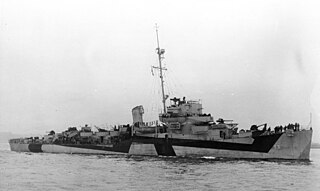
USS Schmitt (DE-676) was a Buckley-class destroyer escort in the United States Navy, commissioned in 1943. In late 1944, she was converted to a high speed transport and was redesignated APD-76. She was retired in 1949 and transferred to the Republic of China Navy in 1969, where she served as ROCS Lung Shan (PF-44) until 1976, when she was scrapped.

USS Daniel T. Griffin (DE-54/APD-38), a Buckley-class destroyer escort of the United States Navy, was named in honor of Ordnanceman Daniel T. Griffin (1911–1941), who was killed in action during the Japanese attack on the Hawaiian Islands.

USS George W. Ingram (DE-62/APD-43) was a Buckley-class destroyer escort in service with the United States Navy from 1943 to 1947. In 1967, she was transferred to Taiwan, serving as Kang Shan until being scrapped in 1979.

USS Lee Fox (DE-65/ADP-45), a Buckley-class destroyer escort of the United States Navy, was named in honor of Ensign Lee Fox (1920–1941), who was killed in action during the Japanese attack on Pearl Harbor, on 7 December 1941.

USS Amesbury (DE-66/APD-46), a Buckley-class destroyer escort of the United States Navy, was named in honor of Lieutenant (jg) Stanton Morgan Amesbury (1916–1942), who was killed in action while flying from the aircraft carrier Ranger (CV-4) during Operation Torch in 1942.

USS Joseph E. Campbell, a Buckley-class destroyer escort of the United States Navy, was named in honor of Ensign Joseph Eugene Campbell (1919–1942), who was killed in action while engaging the enemy on 9 August 1942.

USS Sims (DE-154/APD-50) was a Buckley-class destroyer escort in service with the United States Navy from 1943 to 1946. She was scrapped in 1961.

USS Hopping (DE-155) was a Buckley-class destroyer escort in service with the United States Navy from 1943 to 1947. In 1944, she was converted to a Charles Lawrence-class high speed transport and redesignated "APD-51". She was sold for scrap in 1966.

USS Reeves (DE-156/APD-52) was a Buckley-class destroyer escort in service with the United States Navy from 1943 to 1946. She was transferred to Ecuador for use as an electric generator plant in 1960. Her final fate is unknown.

USS Chase (DE-158/APD-54) was a Buckley-class destroyer escort in service with the United States Navy from 1943 to 1946. She was scrapped in 1946.

USS Loy (DE-160/APD-56), a Buckley-class destroyer escort in service with the United States Navy from 1943 to 1947. She was converted to high-speed transport (APD) in late 1945. Following her decommissioning, she spent another 19 years in reserve before being sold for scrap in 1966.

USS Barber (DE-161/APD-57) was a Buckley-class destroyer escort in service with the United States Navy from 1943 to 1946. In 1969, she was sold to Mexico where she served until 2001.

USS Hubbard (DE-211/APD-53) was a Buckley-class destroyer escort in service with the United States Navy from 1944 to 1946. She was scrapped in 1966.

USS Hayter (DE-212/APD-80) was a Buckley-class destroyer escort in service with the United States Navy from 1943 to 1946. In 1967, she was transferred to South Korea where she served as ROKS Jonnam until 1986.

USS Enright (DE-216/APD-66) was a Buckley-class destroyer escort in service with the United States Navy from 1943 to 1946. In 1967, she was transferred to Ecuador where she served until she was scrapped in 1989.

USS Laning (DE-159/APD-55) was a Buckley-class destroyer escort in service with the United States Navy from 1943 to 1946 and from 1951 to 1957. She was scrapped in 1975.

USS Ringness (APD-100) was a Crosley-class high speed transport that served in the United States Navy from 1944 to 1946. After spending 29 years in reserve, she was sold for scrapping in 1975.

USS John Q. Roberts (APD-94), ex-DE-235, was a United States Navy high-speed transport in commission from 1945 to 1946.

USS Rednour (APD-102) was a Crosley-class high speed transport that served in the United States Navy from 1945 to 1946. In December 1969, she was transferred to Mexico and served under the name Chihuahua until July 2001.

USS Tollberg (APD-103) was a United States Navy high-speed transport in commission from 1945 to 1946. In 1965, Tollberg was transferred to Colombia and served as ARC Almirante Padilla (DT-03) until being stricken and scrapped in 1973.





















